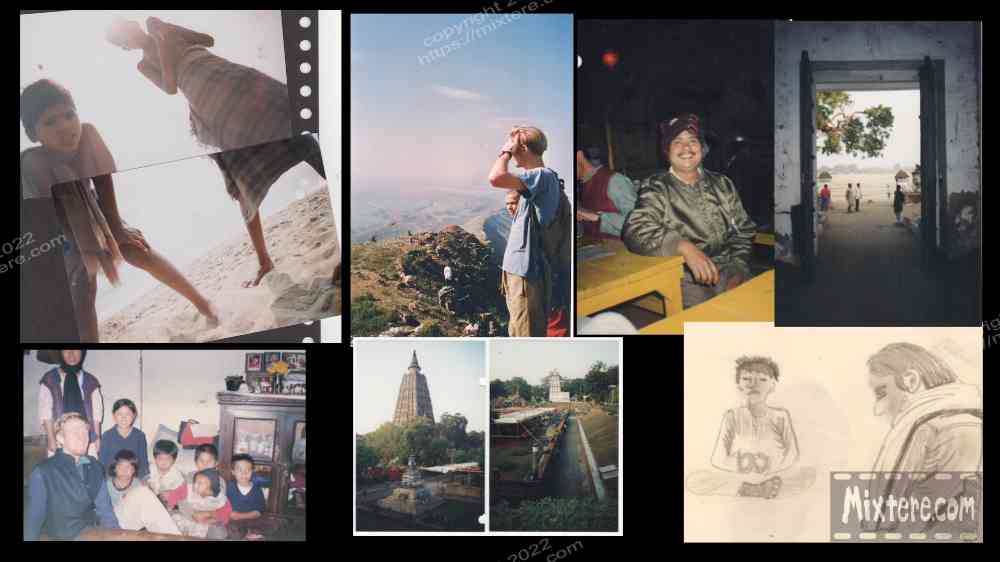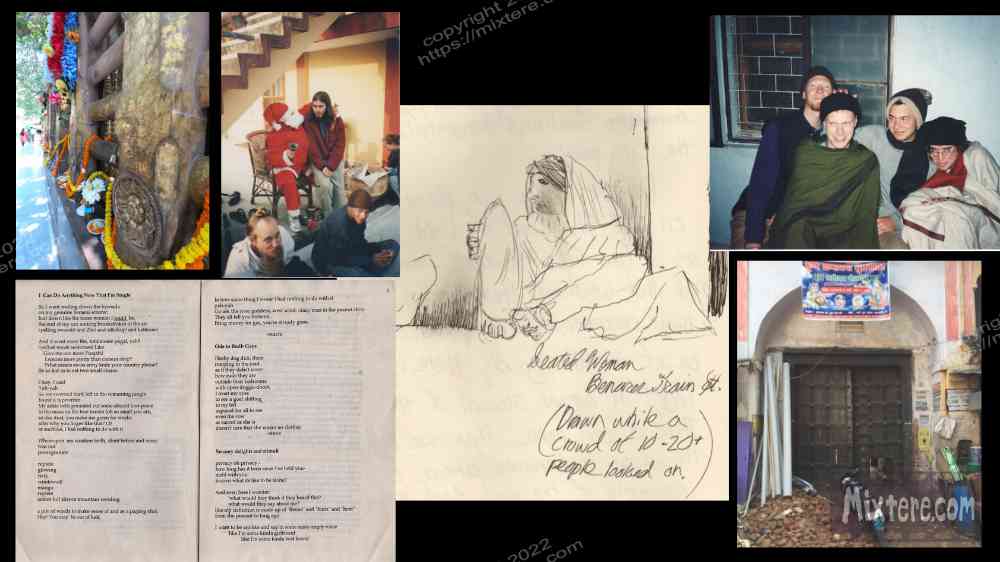
In time the new program director of the Buddhist Studies program welcomed me at the Burmese Vihar . I was struck by how young he seemed. I believe this was his first full year directing the program. Immediately upon meeting this young man I noticed a disconnect between us. It’s a feeling everyone has had, that one that says you’re heading in the opposite directions. I sensed tension in the whole Vihar compound that had not been there during my time there and to this day I am not sure what to attribute it to. A few Burmese on the balcony above glowered down at me between puffs of their cigarettes. This being Bodh Gaya, and a vihar, I tried to smile back but probably did not succeed. When I spoke with the assistant and asked if she had received my messages she responded that she had been busy and that her phone hadn’t been working. When I then I asked if my hand written note had reached her, she shrugged. Sadness and anxiety began to turn in my stomach- this was not the welcome I had imagined.
I was introduced to a few of the new students. They were absorbed in their new world and held little interest in me. I continued sensing a tension, like I was interrupting something and was perceived as an invader of sorts. They were in the middle of the Zen portion of the program, having just finished a month of Theravada studies and meditation practice. I then met the Sensei of this zen portion who had taken over for who had been my Zen teacher about 18 years ago. The new Sensei was very welcoming and kind. His assistant took me in to help me learn some of the ropes before I sat with the students in the zen hall. I was given many directions and was having trouble absorbing it all. I had forgotten how strict it all was. I was to sit this way and bow that way and hold my meditation cushion this way before bowing to it from that direction, etc. Then we were to get up for walking meditation exactly this way and proceed accordingly. When I didn’t get it right I was corrected with urgency before offense could be established.
In joining the program I was struck with a strong sense that I was intruding. Still, the new Sensei welcomed me regardless of my outsider status. He invited me to come to the next evening’s sit for group meditation at the Zen Temple in town. Bodh Gaya has temples, Vihars (sort of pilgrimage hotels) and even universities representative of various Buddhist traditions and countries in Asia. Practitioners from these places often stay or study at these places. I took a rickshaw to what I thought was the right temple but it turned out to be the “other” Zen temple. I was glad I had left early as I just arrived with enough time to again… prevent causing any offense [I hope]. The Bhikkhuni found me, ushered me into the hall, gave me some direction and a spot for our sit. It was the same temple me and my fellow students had done the same thing at 25 years ago. The new batch of students settled down for the sitting. It was early October and they had been in Bodh Gaya for about a month and had only just made the transition to life in Bodh Gaya.
In my time the director had encouraged having clothes made in Bodh Gaya. I don’t know all his reasons for this but I guess it was to better suit the warm climate, to blend in better with the locals and to support the local tailors. I remembered how fun it had been to have clothes made, and how ridiculous some of the outfits turned out. Anyway, I noticed the young western ladies entering the temple wearing beautiful Sari’s sourced and crafted by local tailors.They looked great. Many of the students wore the familiar, serious expressions of those deeply enmeshed in Buddhist studies. I don’t doubt that they were having powerful cultural and spiritual experiences. I noticed the young men sitting ramrod straight on their cushions, some even in full lotus position. The focus on the utmost importance of form and of the rituals associated with Zen practice was evident. I remembered feeling this way too although I had never been able to assume the lotus position.
From what I sensed it seemed that much of the focus was going to the question, “Am I doing it right?” What selective memory had “retained” from my experience so many years ago was a feeling of kinship and camaraderie among students. It had omitted recollections of competition between students and performance anxiety about practice. I now remembered the banter that had often centered around individual “accomplishments. ” These were usually a version of who was braver or more committed, who had eaten what and survived, who had been more adventurous and traveled where on their own, who had haggled better, who could sit better for longer, who was more limber, who had more insight, and of course who received more favoritism from a teacher. I realized the power of the arrogance of youth and how ignorant to India, and to life, I had been at that time. On a new level I realized that for the most part we had been naive, privileged youngsters only a couple of years removed from high school. Now that I was a budget traveler, I realized how very costly the many-thousand dollar price tag for the program had been for a stay in Bihar. This fee must be a signifiant infusion into the local economy. And because of how powerfully enchanting, even spellbinding, an experience like this could be, it could be placed into a category of “spiritual tourism.” In fact, this may be India’s largest tourist niche. I had never put these pieces together before.
A nagging pain was developing and hitting me in nauseating waves. It was a sense that I had come back to claim what was long gone and, perhaps, might never been there in the first place. I did not wish this to happen for the current students. Because of this and projection, I found myself feeling compassion for this new batch of students. I guess they mirrored a younger, more vulnerable version of me. And It is likely that many of them were in the midst of a powerful spell similar to what had taken me over when I was a student. This had been the natural result of living and studying Buddhism in rural Bihar. This was especially powerful at a time of posted mail, little to no internet and spotty fax transmissions. This and the mediation led to a connection to the intuition and sense of movements of the spirit. In contrast, what was palpable about me now was cerebral activity and academic study. But development of progress toward inner peace had come to me much later in life. Life in Bihar and Buddhist study had been the beginning but long ago my path had veered away from Buddhism. I had spent many years seeking the right temple or meditation group in the states yet I had never found anything that came close to our little sangha at the Vihar. Thankfully, in time I was introduced to a Vedanta-based teacher. He had helped me to shed the more cerebral approaches to mediation and understanding of life that I had learned in Bodh Gaya.
Through this teacher, John Goldthwait, I learned to tap into more basic practices focused on stilling the mind and inducing a general compassion for all life on earth. What I was witnessing at this Zen sitting contrasted sharply with where I was now anchored from. All this was trickling in at the zen temple as the sitting commenced. I tried to find my own style of meditation among the strict molds around me. It is dusty in Bodh Gaya and coughs and rustlings emitted from every direction almost every five seconds as people tried to settle in. I struggled with these as I have mostly meditated on my own since leaving Bodh Gaya. Now the recollections came back, how hard it had been to focus on stilling the mind with such distractions.

A memory triggered of sitting with my classmates under the Bodhi Tree guided by our wonderful Vipassana teacher Godwin Samararatne. At that time the road traffic ran right along the edge of the Temple grounds. We would be sitting while busses blasted their horns, belched exhaust and all manner of clatter and voices shot through the walls at us. I remember Godwin responding to this by telling us, “In the hearing, only the hearing.” It probably took me ten years to fully understand what that meant. Anyway, I had never been able to make much progress in meditation in such environments. And beyond them, in quiet nooks, I have. So it no longer made sense to me to try to meditate in such an environment no matter how “holy” a place was. But we were in the very valley where the Buddha had traveled and taught and we sat under what I think was a cutting of the original tree that the Buddha sat under. So academically and religiously, it made sense to try to be as close the source as possible. But I now felt that the essence of the teaching was lost in this process.
After some walking meditation and another stint on the cushions, some chanting brought an end to our evening sit. We all exited the hall and spilled out into the street in search of rickshaws. The director invited me to join them to dinner and I gratefully accepted. Our group made their way to a Tibetan noodle place to have Thukpa. The ever-kind Bhikkhuni made a spot for me beside her at the table. The Thukpa was good and it was nice to sit with the group and other visiting monks in the little tent restaurant. My heart was wrestling with some very unsettling truths and I think it was obvious to those around me that I was struggling. I think that to include me conversation at the table was focused on some of the many changes that Bodh Gaya had experienced since my time there. Conversation drifted to the other end of the table and Katherine took the moment to check in on me. She sensed my struggle at how things were turning out.
I tried to downplay my situation and point out that I was lucky to be able to experience closure after holding on so fiercely to the preciousness of my beloved time in Bodh Gaya. But in truth I was only beginning to start to process this. My expectations of finding home and a community back in Bodh Gaya had to be scuttled. I could not hide that I was now mourning for what I had pined for. The assistant consoled me and said, “You needed to come back. There was no other way.”


